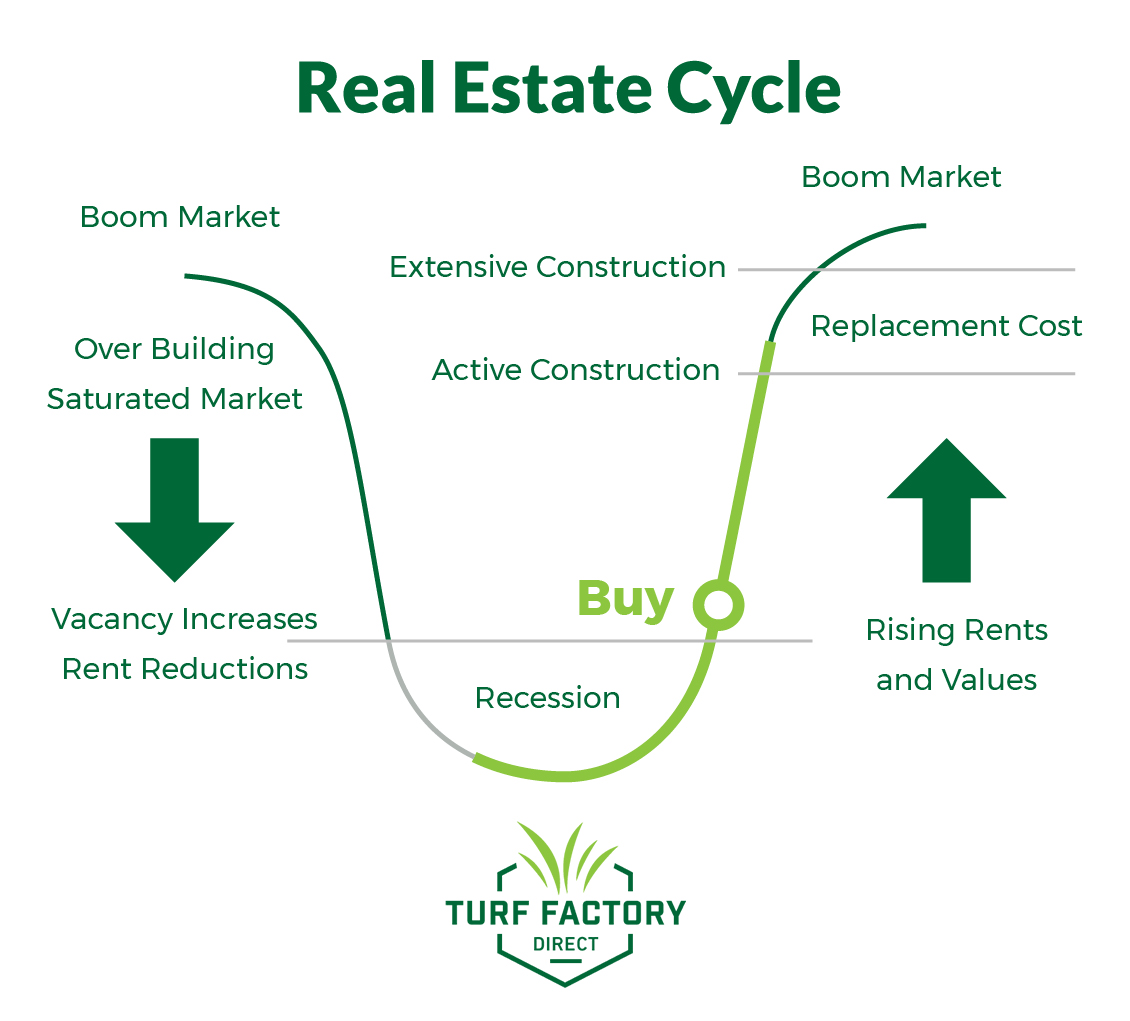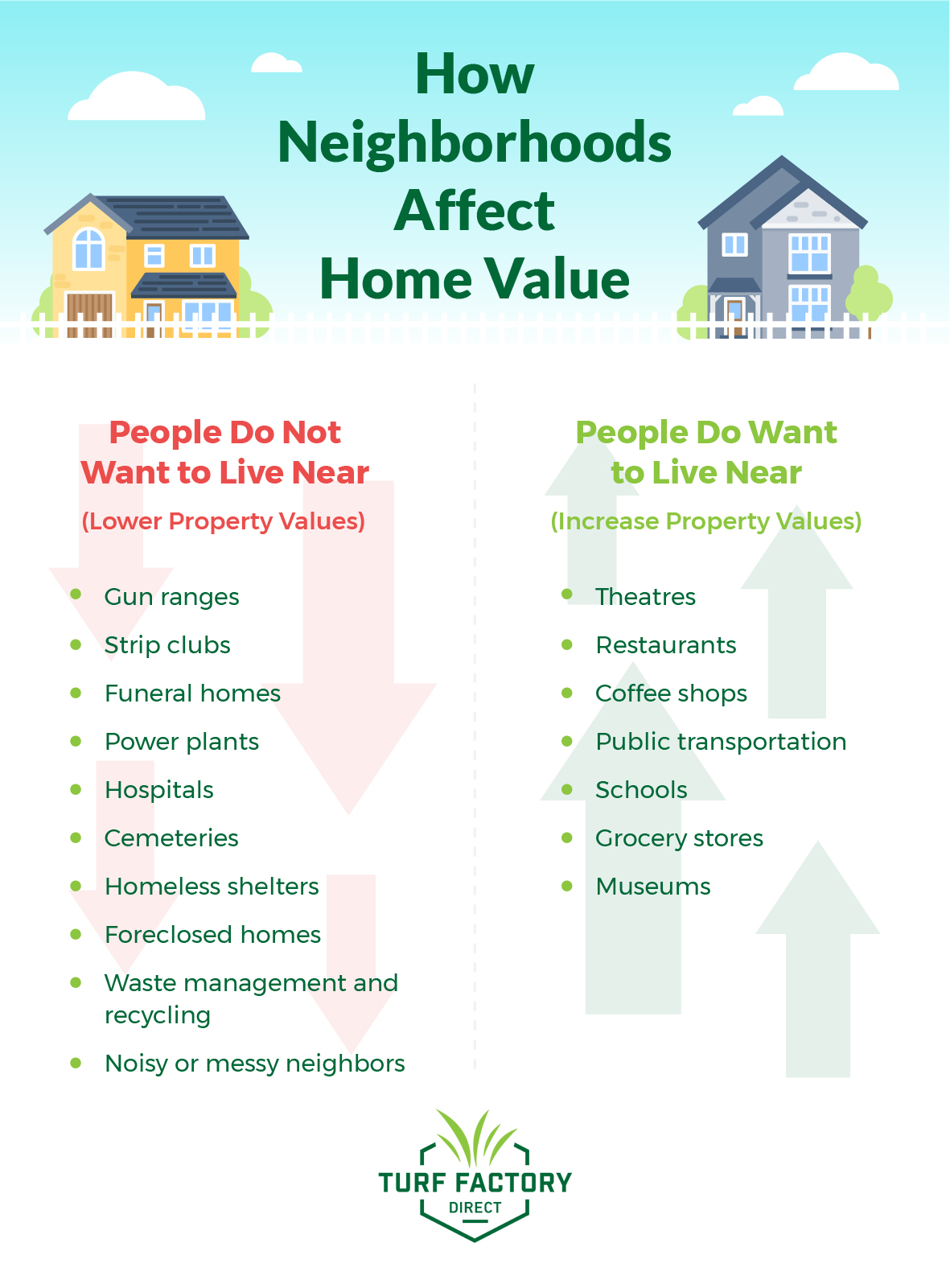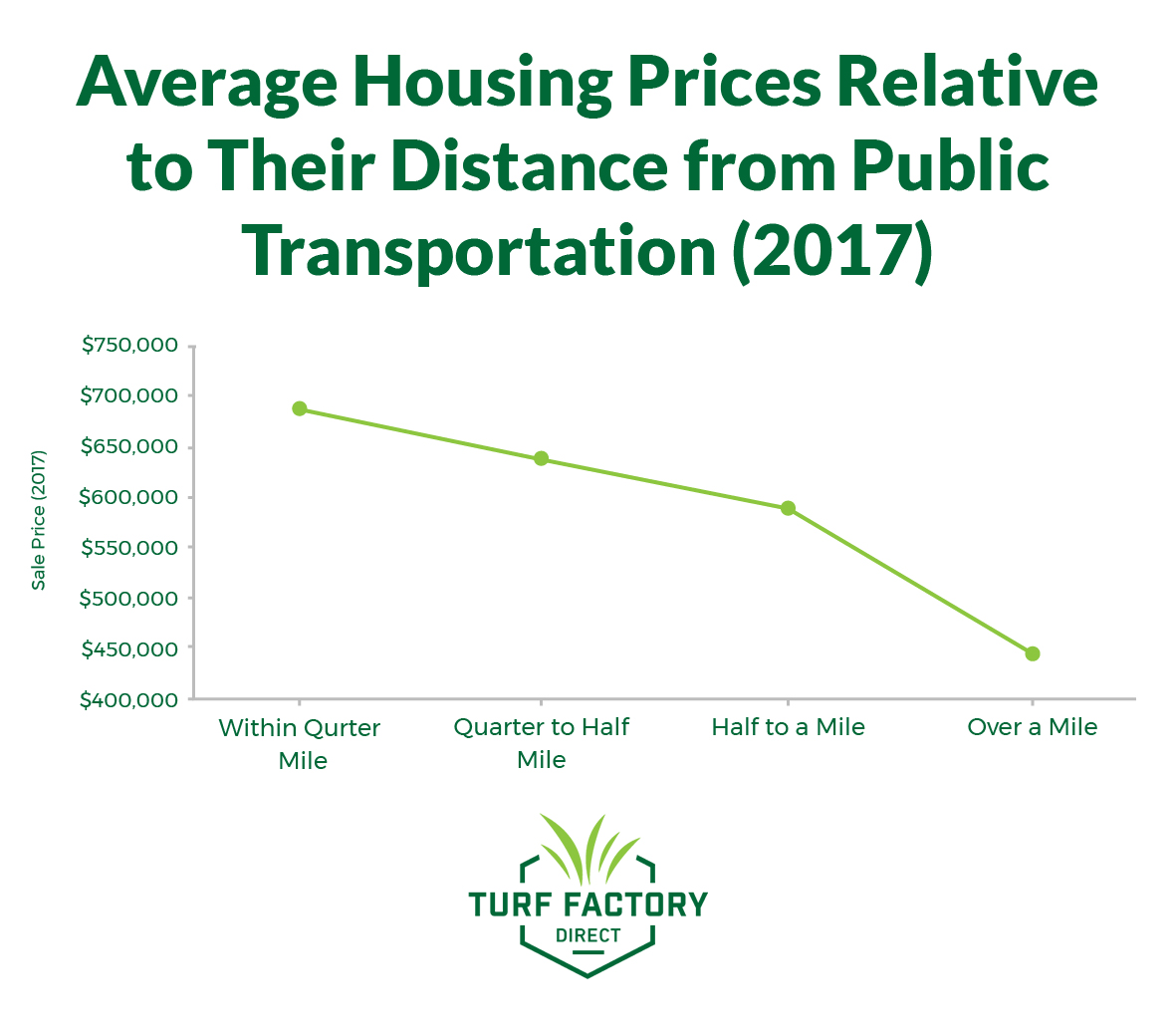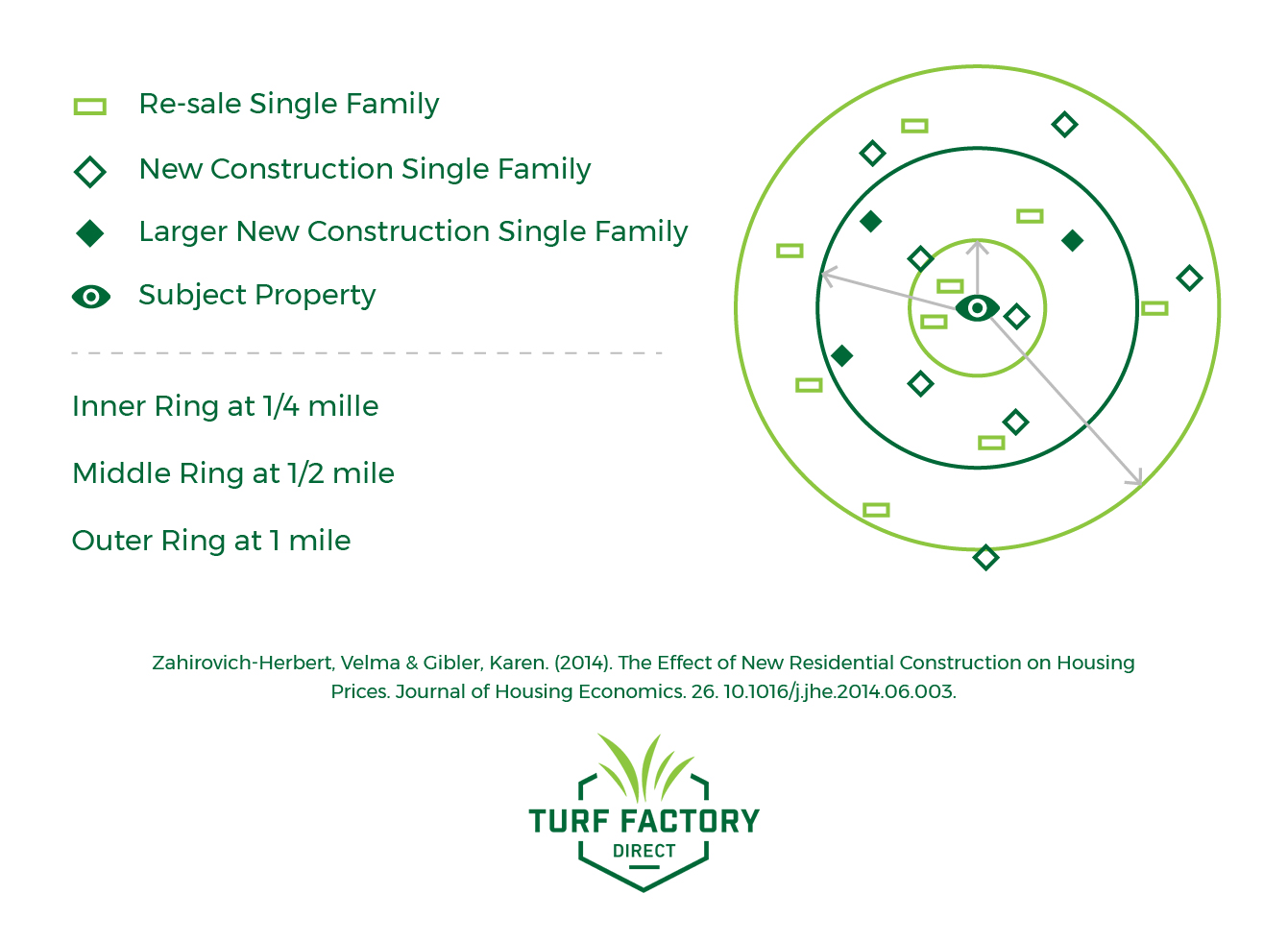
Originally posted on October 2, 2020
Real estate sure is a tricky beast. Wrapping your head around the market feels like trying to nail jelly to a wall. So many things can make a house’s price rollercoaster, like where it sits, if it’s falling apart, or how close it is to your favorite coffee shop.
At Turf Factory Direct, we know the importance of attractive curb appeal and a green lawn for home value. If you’re thinking about increasing the value of your home, consider a turf lawn and explore our selection of landscaping turf.
But, in addition to landscaping for curb appeal, one of the most important factors in raising home values is its proximity to new development. In this post, we’ll show you how development can affect home value, and what it might mean if it starts happening in your area.

What determines a home’s value in the first place?
There are a number of factors and variables that affect the value of a home. The real estate market typically uses the hedonic regression pricing model. The hedonic regression pricing model determines value based on the characteristics of the property itself:
- Size
- Appearance
- Features
- Condition
- Age
In addition to the property itself, hedonic pricing also determines value based on characteristics of its surrounding environment:
- If the neighborhood has a high crime rate
- Is accessible to schools and amenities
- The level of water and air pollution
- The value of other homes close by
Considering Location
While a home location might be convenient for you, the owner, the value of a location is not entirely defined by you. When appraisers look at a home, they check out the employment opportunities in the area, quality of local schools, and the proximity to various amenities, like shopping, restaurants, theatres, and more. This is why some homes that look very nice on their surface are valued lower, as they are in what is perceived to be a less valuable neighborhood.
Considering Home Size & Usable Space
Next up, home quality, determined by size and usable space, is a very important element to consider, as a bigger home positively affects valuation. Usually, a home’s value is roughly estimated in price per square foot, and the sales price divided by the footage of the home. This price can vary, and is often dependent on other factors. Liveable space is given priority— bedrooms and bathrooms are the most highly valued, and the more of these a home offers, the better. However, these trends can be very locally specific.
Considering Interest Rates
Simply put, interest rates matter. As they increase, fewer people are able to afford homes, and this will impact how much your home is worth. Keeping an eye on this is essential when selling or considering buying a home.
 How does new development affect home value?
How does new development affect home value?
Development does a number of things for a neighborhood. As a general rule, development means people want to live where the development is happening, which means more jobs, housing, business, and transportation. This means that new development generally increases the value of a home within close proximity.
New Development Creates New Jobs
Development creates construction jobs, and once the development slows down, you have more businesses and homeowners who are there to expand the employment opportunities in the area and its environs.
New Homes for More People
With the logic of supply and demand, more houses means more supply of both labor and available spending money, which can sometimes mean that a greater supply of houses ultimately affects values (for positive or negative reasons). An abundance of houses and no buyers drives the value down, while a demand greater than the supply drives the value up.
New housing construction usually means new demand for housing, and the new homeowners create the demand for more businesses. New businesses create demand for new homes for employees, and the cycle continues. The change in prices and pricing will depend on the number of homes on the market and the number of homebuyers in the market. In general, home value usually increases from new development.
New Businesses for More Homeowners
New amenities and services increase the value of nearby home because people want to live near those amenities. Employees of those businesses need a place to live, preferably near their work, entertainment, and shopping, increasing the demand for housing and local spending power.

New Transportation for More Homeowners and Businesses
In general, the more transportation access and options available, and the closer proximity to them increases home value. Buses, light rails, bike trails, and increased walkability makes a big difference.

Can new development lower home value?
The answer to this question is: it depends. Whether new development negatively or positively affects a home’s value depends on three variables:
- The type of development
- The proximity of the home to the new development
- Whether the development is ongoing or completed
Depending on the industry of the new development, the value of homes within the vicinity may increase or decrease once the development is completed.
Residential Development
In general, the construction of new homes in the neighborhood increases the value of surrounding homes. Much in the same way new homes indicate increase in jobs and commerce, it can also have an adverse effect. More people means more noise, more pollution, and more traffic.
New homes increase the odds of noisy neighbors and unmaintained homes. However, a well-maintained home will always hold value, and potentially increase the value of surrounding homes in the neighborhood.
Commercial Development
New development that is more likely to decrease home value than increase it, is commercial development. Generally speaking, new commercial development temporarily brings home values down because the process of construction and land development creates noise, unsightly views, road detours, exhaust fumes, and generally just an unpleasant environment to live and work in.
However, once development is complete, whether or not property value increases again depends on the type of industry.
People don’t want to live near new development that produces unpleasant sights, sounds, and smells, such as factories and warehouses. These kinds of developments decrease the value of homes within close proximity.
People do want to live near commercial development that includes theatres, restaurants, boutiques, coffee shops, and other amenities that contribute to cultural enrichment. These kinds of developments increase the value of homes within close proximity a few years after completion.
In the long term and in general, commercial development increases home value, but that depends on its proximity to the home, and the type of industry it is. There are some facilities and businesses that can lower that home’s value if in close proximity years after completion. This includes:
- Gun ranges
- Strip clubs
- Funeral homes
- Power plants
- Hospitals
- Cemeteries
- Homeless shelters
These types of businesses can lower a home’s value because they are not conducive to a friendly environment for families, and can produce significant noise and air pollution.
Access to nearby transportation usually raises home values, but the exceptions that can lower home values are those that contribute to noise pollution and air pollution. This is not all forms of transportation, usually train tracks, freeways, and airports are the forms of transportation within close proximity that can lower property value.
Conclusion
In general, new development increases home value in the long term (with a few exceptions) because new development usually means more opportunities to enrich the community. New development can lower home value in the short term, depending on multiple variables like proximity the type of development.
If you want to start developing your own property and enriching its value, artificial turf is a great place to start. At Turf Factory Direct, we have the tools and material to start you down the path to upgrading your home. Get in touch with us, or start browsing our high quality turf today!







